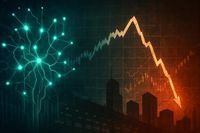Goldman Sachs CEO David Solomon has sent shockwaves through global financial markets with a stark warning: a significant stock market drawdown, potentially driven by artificial intelligence (AI) exuberance, could be looming in the next 12 to 24 months. Speaking at Italian Tech Week in Turin on October 3, 2025, Solomon drew a direct parallel to the Dotcom Bubble, cautioning investors that the current surge in AI-related capital formation risks pushing valuations beyond sustainable fundamentals. "You're going to see a similar phenomenon here. I wouldn't be surprised if in the next 12 to 24 months, we see a drawdown with respect to equity markets," Solomon stated, according to CNBC.
His message comes at a time when major indices like the S&P 500, Nasdaq Composite, and Dow Jones Industrial Average have soared to record highs, largely propelled by the unrelenting optimism surrounding AI. Even as Solomon issued his warning, market sentiment seemed to shrug it off—Dow Futures and S&P 500 futures climbed, buoyed by robust performances from AI stalwarts such as Tesla, Nvidia, Boeing, and Chevron. Yet, beneath this bullish facade, cracks may be forming that could soon rattle not only the equity markets but also the world of digital assets like Bitcoin (BTC) and Ethereum (ETH).
Solomon’s remarks at Italian Tech Week were unambiguous. He highlighted that the rapid acceleration of new technology, especially AI, has led to massive capital inflows that might not deliver the expected returns. "I think that there will be a lot of capital that's deployed that will turn out to not deliver returns, and when that happens, people won't feel good," he warned. The Goldman Sachs chief likened the current AI-driven market excitement to previous technology cycles, underscoring that while innovation spurs growth and creates new winners, it also invites speculative excess. "You generally see the market run ahead of the potential… there are going to be winners and losers," he added, according to CNBC.
This historical comparison is more than just a rhetorical device. The Dotcom Bubble of the late 1990s and early 2000s saw vast sums of money poured into internet companies, many of which ultimately failed to deliver lasting value. Solomon’s analogy suggests that, despite AI’s transformative promise, the present market enthusiasm may be outpacing reality, setting the stage for an inevitable correction.
Solomon’s warning is not an outright dismissal of AI’s potential. Far from it. He acknowledged the fundamental reality and revolutionary power of AI, but urged investors to temper their exuberance and prepare for a more rational, fundamentals-driven market environment. This sentiment was echoed by other luminaries at Italian Tech Week, including Amazon founder Jeff Bezos, who described AI as being in an "industrial bubble" while reaffirming its capacity to reshape every industry.
Solomon’s cautionary outlook extends beyond stocks to the cryptocurrency markets. According to CNBC, he noted that a stock market drawdown often correlates with heightened volatility in digital assets. Bitcoin, for instance, has sometimes acted as a hedge during previous equity corrections, attracting institutional flows as investors seek alternatives. However, the interconnected nature of markets means that a sharp equity correction could trigger selloffs across risk assets, including altcoins. Traders are advised to watch key support levels for major indices like the S&P 500; if breached, this could amplify selling pressure in both equities and cryptocurrencies.
Historical data backs up Solomon’s concerns. In 2022, when stocks plummeted amid inflation fears, crypto markets experienced steep declines followed by recoveries, underscoring the tight coupling between these asset classes. For traders, the message is clear: volatility indicators such as the VIX may spike during turmoil, leading to increased trading volumes in ETH pairs and boosting liquidity for tokens like Solana and Chainlink. On-chain metrics—such as whale accumulations and large BTC transfers—could also signal market turning points.
Institutional investors are already adjusting their playbooks. Hedge funds have reportedly increased crypto holdings by 15% year-over-year, a trend that could accelerate if a drawdown materializes. This shift may bolster the market caps of leading cryptocurrencies, with Ethereum potentially testing $4,000 if stock sell-offs drive portfolio reallocations. Meanwhile, stablecoins like USDT and USDC may become safe havens during periods of heightened uncertainty.
Within the AI sector, Solomon’s warning draws a sharp line between potential winners and losers. Companies with established positions and diversified AI offerings—such as Nvidia, Microsoft, Alphabet, and Amazon—are seen as more resilient due to their robust infrastructure and strong balance sheets. These firms are investing heavily in AI, including proprietary chips and strategic startup funding, positioning themselves to weather any storm. Other key players like Advanced Micro Devices, Taiwan Semiconductor Manufacturing, Marvell Technology, and Micron Technology are also likely to endure, given their critical roles in the hardware supply chain.
On the flip side, companies whose valuations have soared on speculative enthusiasm without a clear path to profitability are at significant risk. Solomon specifically noted that 95% of AI pilot projects fail to yield meaningful results, making firms unable to demonstrate return on investment particularly vulnerable. Hyperscalers with strained margins and those involved in "circular deals"—where companies invest in their own customers—could face intense scrutiny if market demand fails to materialize. The result may be heightened volatility and a "flight to safety" toward firms with proven AI revenue streams and solid fundamentals.
Solomon also touched on broader economic and regulatory themes. He called for more efficient channeling of European savings into the risk economy and tech ecosystem, criticizing the slow pace of European regulatory processes. Internally, Goldman Sachs plans to spend $6 billion on technology investments this year, with an eye toward increasing that to $8 billion if feasible. Despite his cautious market outlook, Solomon predicted an acceleration of the US economy into 2026, fueled by government spending and ongoing AI infrastructure build-out. He also noted an uptick in mergers and acquisitions and capital markets activity, a welcome change from the investment banking slowdown seen in late 2022 and early 2023.
The implications of Solomon’s warning extend far beyond Goldman Sachs. Other financial institutions are likely to follow suit, scrutinizing their AI-related exposures and tightening lending standards for startups. Tech giants pouring hundreds of billions into AI infrastructure will face greater demands for ROI transparency. Regulators could step up oversight of speculative activities and "circular financing" deals, while financial stability bodies like the IMF may increase analysis of how AI-driven products could amplify market shocks.
Looking ahead, Solomon’s nuanced perspective suggests a period of short-term volatility followed by long-term opportunity. While he anticipates a correction, he sees it as a healthy reset, repricing assets to reflect more realistic expectations and allowing sustainable, fundamentals-driven growth. For investors, this means scrutinizing company earnings, monitoring regulatory developments, and differentiating between AI players with clear monetization paths and those simply riding the hype cycle. A correction, though painful, could present rare buying opportunities in fundamentally strong companies tied to the enduring AI megatrend.
As markets stand at an AI-fueled crossroads, Solomon’s warning is a clarion call for caution, discernment, and resilience. The coming months will reveal which companies—and investors—are prepared to weather the storm and thrive in the next era of technological transformation.





